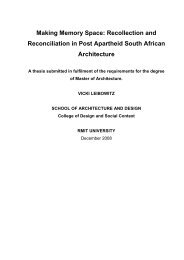Objects in Flux - RMIT Research Repository - RMIT University
Objects in Flux - RMIT Research Repository - RMIT University
Objects in Flux - RMIT Research Repository - RMIT University
Create successful ePaper yourself
Turn your PDF publications into a flip-book with our unique Google optimized e-Paper software.
<strong>Objects</strong> <strong>in</strong> <strong>Flux</strong><br />
136<br />
tion. In addition, effective modes of resistance may be found with<strong>in</strong><br />
the practice itself. Documents such as the ‘Makers Bill of Rights’<br />
(Jalopy, 2005) and the ‘Repair Manifesto’ (Platform21, 2009), while<br />
hav<strong>in</strong>g little commercial <strong>in</strong>fluence, <strong>in</strong>dicate a high level of political<br />
awareness with<strong>in</strong> the practice and suggest a degree of organized<br />
resistance. Whether practices of object modification are effective <strong>in</strong><br />
escap<strong>in</strong>g commercial control may however lie <strong>in</strong> the disorganized<br />
resistance they offer. If commercial <strong>in</strong>stitutions fail to capture these<br />
practices as productive labor this will probably be due to the practices<br />
irreducibility to <strong>in</strong>stitutionalized logic and its endlessly adaptive, adhoc<br />
approach to its environment.<br />
7.7 Active engagement<br />
My participation <strong>in</strong> the field of object modification has highlighted the<br />
process-driven nature of these activities. The overwhelm<strong>in</strong>g experience<br />
has been one of perpetual engagement where actions rema<strong>in</strong><br />
open and responsive to the conditions of their environment. The modified<br />
object, far from be<strong>in</strong>g the sum of the practice, becomes a conduit<br />
through which the practice takes place (Warde, 2005, p. 138). While<br />
stories from the field, such as those presented <strong>in</strong> chapter five, beg<strong>in</strong> to<br />
give <strong>in</strong>sight <strong>in</strong>to this experience, there rema<strong>in</strong>s aspects of the practice<br />
that cannot be captured or represented. These stories do not simply<br />
describe the practice, they enact it. As de Certeau states, ‘The story<br />
does not express a practice … it makes it. One understands it, then, if<br />
one enters <strong>in</strong>to this movement oneself’ (1984, p. 81).<br />
In order to ga<strong>in</strong> a deep understand<strong>in</strong>g of these practices the <strong>in</strong>dividual<br />
must actively engage these stories. For me, this engagement has been<br />
a reward<strong>in</strong>g experience that has permanently changed my relationship<br />
to the objects <strong>in</strong> my life. Through publicly document<strong>in</strong>g this experience<br />
via the research blog I hope my activities provide encouragement<br />
to others – as I, <strong>in</strong> turn, have been encouraged by others. I encourage<br />
you to take up a role of object modifier and actively engage your material<br />
environment. From the evidence given <strong>in</strong> this research, there is a<br />
very good chance that this is someth<strong>in</strong>g you already do.
















